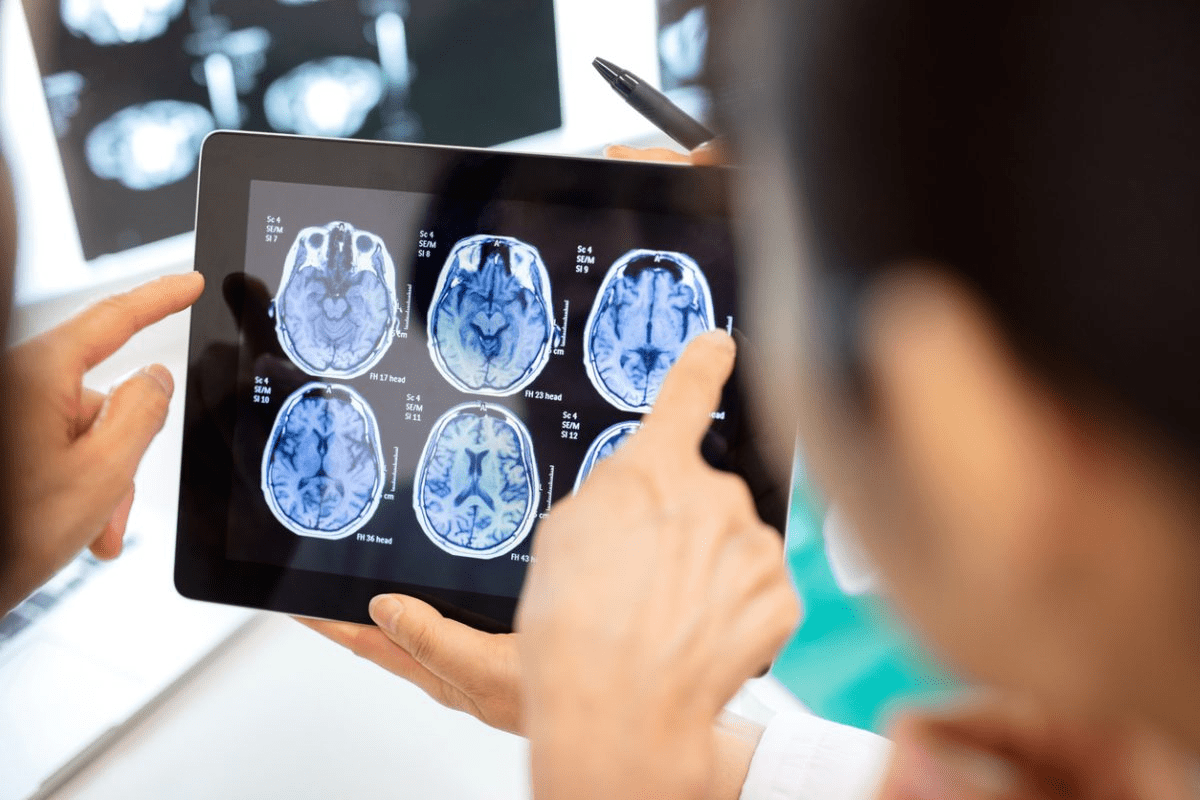Last Updated on November 27, 2025 by Bilal Hasdemir

At LivHospital, we know how vital diagnostic imaging is for spotting infections in the abdomen and pelvis. CT scans are key in finding issues like abscesses and inflammatory diseases. But it’s important to know the risks these tools can pose.
We rely on CT scans to spot infections in the abdominal and pelvic areas. This is critical for treating these conditions effectively. Though CT scans are powerful, they expose patients to radiation and contrast agents. These can harm some people.
Key Takeaways
- CT scans are vital for diagnosing abdominal and pelvic infections.
- Knowing the risks of CT scans is key to safe care.
- Contrast agents in CT scans can trigger allergic reactions in some.
- Patients with kidney issues are at higher risk of kidney failure after a CT scan with contrast.
- Radiation from CT scans slightly raises cancer risk.
The Critical Role of Abdominal and Pelvic CT Scans

Abdominal and pelvic CT scans are key in today’s medicine. They give doctors important clues about health problems. These scans help doctors find and treat many illnesses.
What These Diagnostic Images Reveal
CT scans show detailed pictures of the inside of the abdomen and pelvis. They help doctors see infections, tumors, and other issues. This lets doctors understand symptoms and plan the best treatment.
These scans are very useful. They can spot problems like appendicitis and injuries to organs. Doctors use them to find and fix many health issues.
Technological Foundations of CT Scanning
CT scanning uses X-rays and computers to make images. A rotating X-ray tube and detector capture pictures. Then, computers turn these into detailed views of the body.
CT scanning has gotten much better over time. Today’s scanners make clear images fast. This means doctors can make accurate diagnoses quickly.
| Technological Advancements | Benefits of Abdominal and Pelvic CT Scans |
| High-resolution imaging | Improved diagnostic accuracy for complex conditions |
| Rapid scanning capabilities | Reduced examination time, enhanced patient comfort |
| Advanced image reconstruction algorithms | Enhanced visualization of internal structures and abnormalities |
CT Scan Infection Detection: Capabilities and Applications

Advanced CT scanning technology has greatly improved the ability to find infections in the abdomen and pelvis. We use this tech to spot and manage infections quickly and effectively.
CT scans are key in finding abscesses and inflammatory diseases. An abscess is a pocket of pus that can show up in the abdomen and pelvis. These scans let us see these abscesses clearly, helping us plan the right treatment.
Identifying Abscesses and Inflammatory Diseases
CT scans are great at spotting abscesses and inflammatory diseases because they give us detailed images. We can see how big, where, and how far these issues spread. This info is key to choosing the right treatment.
Using contrast agents during a CT scan makes it even better at showing infections. These agents help us see different parts of the body more clearly, making it easier to find infections or inflammation.
Visualization Capabilities for Infectious Processes
CT scans are vital for seeing how bad an infection is. They give us detailed pictures of the infected areas. This lets us understand the situation well and plan the best treatment.
Here’s a quick look at why CT scans are so good at finding infections:
| Benefit | Description |
| High-resolution imaging | Allows for precise diagnosis of abscesses and inflammatory diseases |
| Contrast enhancement | Enhances visualization of infectious processes and affected tissues |
| Accurate assessment | Enables assessment of the size, location, and extent of infectious conditions |
By using CT scans, we can help patients get better faster. We can give them accurate diagnoses and effective treatments for infections in the abdomen and pelvis.
Common Infections Detected Through Abdominal CT Imaging
Advanced CT imaging helps doctors spot abdominal infections accurately. Abdominal CT scans are key for finding infections in the belly area. They show internal details, helping doctors plan the best treatment.
Gastrointestinal Tract Infections
Gastrointestinal tract infections are common. A CT scan of the stomach can diagnose them. These infections can lead to inflammation or abscesses, seen on a CT scan.
Conditions like diverticulitis, appendicitis, and infectious colitis can be found. CT scans help treat these infections quickly and correctly.
Liver and Biliary System Infections
Infections in the liver and biliary system, like cholangitis and liver abscesses, can be found with CT and pelvis with contrast. The contrast makes these infections clearer. This helps doctors diagnose more accurately.
CT scans show how big the infection is. They help decide the best treatment, like drainage.
Pancreatic and Splenic Infections
Pancreatic and splenic infections are serious. They can be diagnosed with an abdominal CT scan with contrast. These infections can be dangerous if not treated quickly.
CT scans show the pancreas and spleen in detail. They help find infections like pancreatitis or splenic abscesses. This info is key to a good treatment plan.
In conclusion, abdominal CT imaging is a powerful tool for finding infections in the belly. CT scans give detailed images, helping doctors diagnose and treat infections well. Contrast agents make CT scans even better, making them essential in healthcare.
Pelvic CT Scan Applications for Infection Diagnosis
Pelvic CT scans are key in finding infections in the reproductive and urinary systems. They give detailed images. These help doctors spot and check different conditions.
Reproductive System Infections and Complications
Pelvic CT scans are great for finding infections and problems in the reproductive system. They can spot pelvic inflammatory disease (PID), tubo-ovarian abscesses, and other infections. These can affect the uterus, ovaries, or fallopian tubes.
For example, a CT scan can show if the ovaries are big or if there are complex adnexal masses. These signs mean there might be an infection or abscess. Knowing this helps doctors decide on treatment, like antibiotics or surgery.
Urinary System Infection Assessment
Pelvic CT scans are also good for checking infections in the urinary system. They can find pyelonephritis (kidney infection) and urinary tract infections (UTIs) that have gotten worse.
A pelvic CT scan can see signs of infection, like inflammation or abscesses, in the kidneys, ureters, or bladder. This is very important for people with severe symptoms or those at risk because of other health issues.
Abscess Detection in the Pelvic Region
Pelvic CT scans are also great for finding abscesses in the pelvic area. Abscesses are pockets of pus that form from infection. They need quick treatment to avoid more problems.
CT scans are very good at finding abscesses. They show how big they are, where they are, and how they relate to other parts. This info is key for planning the right treatment, like draining the abscess or using antibiotics.
| Condition | CT Scan Findings | Clinical Implications |
| Pelvic Inflammatory Disease (PID) | Enlarged ovaries, complex adnexal masses | Antibiotic treatment, possible surgery |
| Urinary Tract Infection (UTI) | Inflammation or abscesses in the kidneys, ureters, or bladder | Antibiotics, watching for more problems |
| Abscess in the Pelvic Region | Pocket of pus, size, and location | Drainage or antibiotics |
The Importance of Contrast in CT Chest, Abdomen, and Pelvis Scans
Contrast agents are key in making infections visible on CT scans. They help show the differences between body tissues and structures. This makes it easier to spot any problems.
How Contrast Enhances Infection Visualization
Contrast agents help us see infected tissues on CT scans. They gather in areas of inflammation or infection. This makes these areas clear in the images.
Using contrast in CT scans has many benefits:
- It helps find abscesses and inflammation better.
- It shows how big an infection is.
- It makes complex body structures clearer.
CT Thorax Abdomen Pelvis With Contrast: Benefits and Procedures
CT scans of the chest, abdomen, and pelvis with contrast give a full view of these areas. A contrast agent is given through an IV before the scan.
This method has many advantages:
- It checks many body parts at once.
- It finds infections and other problems better.
- It helps decide on treatment for complex cases.
Potential Risks and Allergic Reactions
While CT scans with contrast are safe, there are risks and allergic reactions. Some people might feel sick or itch. Others could have serious reactions like anaphylaxis.
We check each patient’s health before giving contrast. We watch them closely during and after the scan. This way, we can act fast if they have a bad reaction.
Important things to think about with contrast include:
- Any allergies or past reactions to contrast.
- How well the kidneys work, as contrast can affect them.
- How contrast might interact with other medicines.
When Physicians Order a CT Scan of the Abdomen and Pelvis
Doctors often use CT scans of the abdomen and pelvis to find the cause of many health issues. These scans give important details that help doctors decide on the best treatment. They also help in managing a patient’s care.
Evaluating Unexplained Abdominal Pain
One main reason for a CT scan of the abdomen is to figure out why someone has unexplained belly pain. This pain can come from many sources, like problems in the gut or organs. A CT scan shows detailed pictures of the belly’s organs and structures.
Investigating CT Scan Bowel Problems
Bowel issues, like blockages, inflammation, or infections, also lead to CT scans of the abdomen and pelvis. These scans can find problems like diverticulitis, inflammatory bowel disease, or blockages. This allows for quick action.
With the detailed images from a CT scan, doctors can see how bad the bowel problem is. They can then plan the right treatment, which might be medicine or surgery.
CT Scan for Stomach Ache: When It’s Necessary
A CT scan for stomach ache is usually needed when the pain is very bad, lasts a long time, or comes with other serious symptoms like fever or vomiting. These scans can find the real reason for the stomach pain. It could be something simple like gastritis or a more serious issue like a perforated ulcer.
In summary, CT scans of the abdomen and pelvis are key tools for doctors. They help diagnose and manage many belly and pelvic problems. These scans give clear images that help doctors make the best decisions for their patients.
Procedure Protocols: CT Abd Pelvis With and Without Contrast
CT scans of the abdomen and pelvis are key to finding infections. They let us see these areas in detail. This helps us spot different health problems.
Protocol Selection Based on Suspected Pathology
Choosing between a CT scan with or without contrast depends on what we think might be wrong. Contrast-enhanced scans are great for seeing things like abscesses or tumors. They give clearer pictures of these issues.
- Contrast scans help find infections by showing inflammation or abscesses.
- Without contrast, CT scans can spot things like kidney stones or injuries.
Abdominal and Pelvic CT Scan With Contrast Procedure
The contrast agent has iodine or barium. These substances make blood vessels, organs, and problems stand out on the CT images. We watch patients for any bad reactions to the agent.
Abdominal and Pelvic CT Scan Without Contrast: When Preferred
Sometimes, we choose not to use contrast for a CT scan. This is true for patients with kidney disease. The contrast could make things worse.
- Non-contrast scans are fast and useful in emergencies when contrast can’t be used.
- They’re also good for finding stones in the urinary tract.
Knowing when to use each type of scan helps us choose the best way to diagnose each patient.
Radiation Exposure Concerns in CT Scanning
CT scans are key for spotting infections and other issues in the abdomen and pelvis. But they come with radiation risks. These scans use X-rays, exposing patients to ionizing radiation.
Quantifying Radiation Doses in Abdominal and Pelvic CT
The dose from a CT scan is measured in millisieverts (mSv). For scans of the abdomen and pelvis, doses range from 10 to 20 mSv. This is more than the yearly background radiation most people get.
Minimizing Exposure for Vulnerable Populations
Children, pregnant women, and those needing many CT scans face higher risks. To lower these risks, we use low-dose CT protocols for them. New CT tech also helps, making images at lower doses.
It’s also key to only do CT scans when they’re really needed. This makes sure the benefits are worth the risks.
Balancing Diagnostic Benefits Against Radiation Risks
Though radiation is a worry, CT scans have big benefits. They can save lives by helping diagnose and treat serious issues quickly. We need to use CT scans wisely and make them as low-dose as possible.
This way, we get the needed info for patients while keeping radiation exposure down.
Distinguishing Between Abdominal and Pelvic Regions in CT Imaging
It’s important to know the difference between the abdominal and pelvic regions for accurate CT imaging. This knowledge helps doctors make the right diagnosis and treatment plan. The distinction between these areas is key to this process.
Anatomical Boundaries: Pelvic vs Abdominal
The abdominal and pelvic regions are next to each other but are different. The abdominal area goes from the diaphragm to the pelvic brim. It includes important organs like the liver, spleen, and intestines.
The pelvic area starts at the pelvic brim and has organs like the reproductive organs, bladder, and rectum.
Key differences in CT imaging between these regions include:
- The type of organs present and their functions
- The structure of the surrounding musculature and skeleton
- The presence of specific pathological conditions is more common in one region
CT Scan Lower Abdomen: Specific Applications
CT scans of the lower abdomen are great for finding issues with the intestines, like diverticulitis or appendicitis. They can also spot problems with the urinary tract, like kidney stones.
Some specific applications include:
- Evaluating abdominal pain of unknown origin
- Assessing injuries to abdominal organs
- Guiding biopsies or other interventional procedures
When Both Regions Require Examination
Often, both the abdominal and pelvic regions need to be checked together. This is true for conditions that can spread across these areas, like some cancers or infections.
Benefits of combined abdominal and pelvic CT scans include:
- Comprehensive assessment of complex conditions
- Improved staging of diseases that involve both regions
- Enhanced planning for surgical or radiation therapy interventions
Conclusion: Advances in CT Imaging for Safer Infection Detection
CT imaging has made big strides in finding infections, like those in the belly and pelvis. Modern CT scans can spot infections better, helping doctors treat them fast and right.
New tech, like contrast-enhanced imaging, makes seeing infections clearer. This is great for finding tough cases like abscesses and inflammatory diseases. It helps doctors do more precise treatments.
We’re excited for what the future holds in CT imaging. With ongoing improvements, we’ll see even better results in finding infections safely. Our goal is to keep making healthcare better for everyone.
FAQ
What is a CT scan, and how does it help in diagnosing infections in the abdominal and pelvic regions?
A CT scan uses X-rays and computer tech to show detailed images of the body. It helps find infections by showing what’s inside the belly and pelvis. This helps spot abscesses and other problems.
What are the risks associated with CT scans, particularly in terms of radiation exposure?
CT scans use radiation, which can slightly increase cancer risk. But, they’re often needed to find serious health issues. We try to use less radiation, mainly for those who are more sensitive.
How does contrast material enhance the visualization of infections during a CT scan?
Contrast material is given through an IV to make certain body parts stand out on a CT scan. This makes it easier to see infections and other issues.
What are the common infections detected through abdominal CT imaging?
Abdominal CT scans can find infections in the gut, liver, pancreas, and spleen. Finding these infections early is key to treating them well.
How are pelvic CT scans used in diagnosing infections?
Pelvic CT scans help find infections in the reproductive and urinary systems. They also spot abscesses in the pelvis. Contrast material helps make these scans more accurate.
When is a CT scan of the abdomen and pelvis ordered, and what does it help diagnose?
Doctors order CT scans to check for unknown belly pain or bowel issues. They also use them to diagnose stomach problems. These scans help decide the next steps in treatment.
What is the difference between a CT scan with contrast and one without contrast?
A CT scan with contrast uses a material to highlight body parts. Without contrast, it doesn’t. The choice depends on what the doctor thinks might be wrong.
How do protocol selections for CT abdomen and pelvis scans depend on the suspected pathology?
The type of CT scan depends on what the doctor thinks might be wrong. Scans with contrast are often for infections or tumors. Without contrast, they’re for injuries or other conditions.
What are the anatomical boundaries that distinguish the abdominal and pelvic regions in CT imaging?
The belly is between the diaphragm and the pelvic brim. The pelvis is below the brim. Knowing these areas is key to correct diagnosis and treatment.
How are advances in CT imaging technology improving the detection of infections?
New CT tech, like better resolution and faster scans, helps find infections better. This makes diagnosis safer and more accurate, improving patient care.
References
- Thomassin-Naggara, I., et al. (2012). Gynecological pelvic infection: What is the role of imaging? Diagnostic and Interventional Imaging, 93(5), 375-381. Retrieved October 2025, from https://www.sciencedirect.com/science/article/pii/S2211568412001441
- Caraiani, C., et al. (2020). Indications for abdominal imaging: When and what to choose? Abdominal Radiology, 45(3), 548-559. Retrieved October 2025, from https://pmc.ncbi.nlm.nih.gov/articles/PMC7266076/






